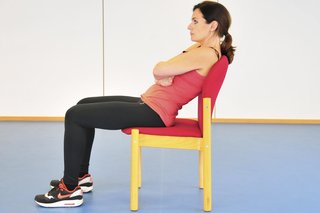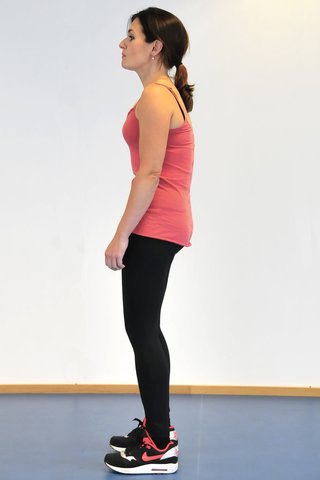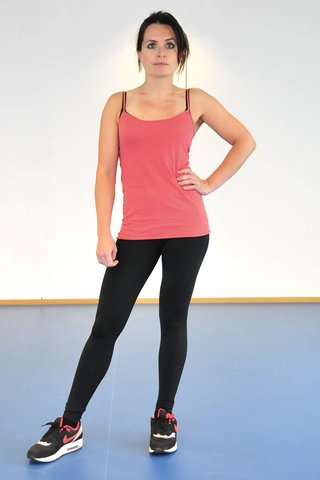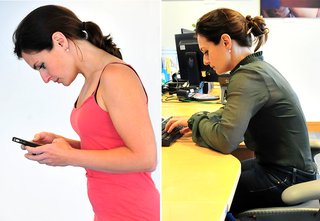Exercises and tips to help alleviate muscle tension caused by poor sitting and standing habits.
Physiotherapist Nick Sinfield describes 8 common posture mistakes and how to correct them with strength and stretching exercises. If you have back pain, improving your posture is unlikely to address the root cause of your pain, but it may help alleviate muscle tension.
"Correcting your posture may feel awkward at first because your body has become so used to sitting and standing in a particular way," says Sinfield.
"But with a bit of practise, good posture will become second nature and be 1 step to helping your back in the long term."
Slouching in a chair

This strain may increase tension in the muscles, which may in turn cause pain.
Get into the habit of sitting correctly. It may not feel comfortable initially because your muscles have not been conditioned to support you in the correct position.
Exercises to strengthen your core and buttock muscles, and back extensions, will help correct a slouching posture.
Exercises to correct a slumping posture:
- bridges
- back extensions
- plank
Sticking your bottom out


Wearing high heels, excessive weight around the stomach and pregnancy can all contribue to a "Donald Duck" posture.
Exercises to correct a "Donald Duck" posture:
- plank
- side-lying leg raises
- hip flexor stretches
- standing thigh stretch
To help correct your standing posture, imagine a string attached to the top of your head pulling you upwards.
The idea is to keep your body in perfect alignment, maintaining the spine's natural curvature, with your neck straight and shoulders parallel with the hips:
- keep your shoulders back and relaxed
- pull in your abdomen
- keep your feet about hip distance apart
- balance your weight evenly on both feet
- try not to tilt your head forward, backwards or sideways
- keep your legs straight, but knees relaxed
Watch a video on improving your posture.
Standing with a flat back

This posture is often caused by muscle imbalances, which encourage you to adopt such a position. Spending long periods sitting down can also contribute to a flat back.
A flat back also tends to make you lean your neck and head forwards, which can cause neck and upper back strain.
Exercises to strengthen your core, buttocks, neck and rear shoulder muscles, and back extensions, are recommended to help correct a flat back.
Exercises to correct a flat back:
- plank
- side-lying leg raises
- chest stretches
- seated rows in a gym, or pull-ups
- back extensions
Leaning on 1 leg

Over time, you may develop muscle imbalances around the pelvis area, which can cause muscular strain in the lower back and buttocks.
Other causes of uneven hips include carrying heavy backpacks on 1 shoulder, and parents carrying toddlers on 1 hip.
To improve this posture, try to get into the habit of standing with your weight evenly distributed on both legs.
Exercises to strengthen your buttocks and core muscles will help correct uneven hips:
- plank
- side-lying leg raises
- bridges
Hunched back and 'text neck'

When hunching over a computer, your head may tend to lean forward, which can lead to poor posture. Using a mobile can cause similar problems dubbed "text neck".
Upper back, neck and rear shoulder strengthening exercises, chest stretches and neck posture drills are recommended to help correct a hunched back.
Exercises to correct a hunched back:
- gently lengthening your neck upwards as you tuck in your chin
- seated rows in a gym or pull-ups
- chest stretches
Poking your chin

Correcting a poking chin involves improving your sitting habits and exercises to correct your posture.
How to correct a poking chin:
- gently lengthen your neck upwards as you tuck in your chin
- bring your shoulder blades down and back towards your spine
- pull in your lower tummy muscles to maintain a natural curve in your lower back
- adjust your seating
Rounded shoulders

Rounded shoulders are typically caused by poor posture habits, muscle imbalances and focusing too much on certain exercises, such as too much focus on chest strength while neglecting the upper back.
Exercises to strengthen your core, upper back and chest muscles will help correct rounded shoulders:
- plank
- bridges
- seated rows in a gym or pull-ups
- chest stretches
Cradling your phone

Over time, this posture can place strain on the muscles and other soft tissues, and lead to muscle imbalances between the left and right side of your neck.
Try to get into the habit of holding the phone with your hand, or use a hands-free device.
Exercises for neck stiffness and pain:
- chest stretches
- neck stretches – gently lower your left ear towards your left shoulder; hold for 10 to 15 deep breaths, then repeat on opposite side
- neck rotations – slowly turn your chin towards 1 shoulder; hold for 10 to 15 deep breaths, then repeat on opposite side
Share..
No comments:
Post a Comment